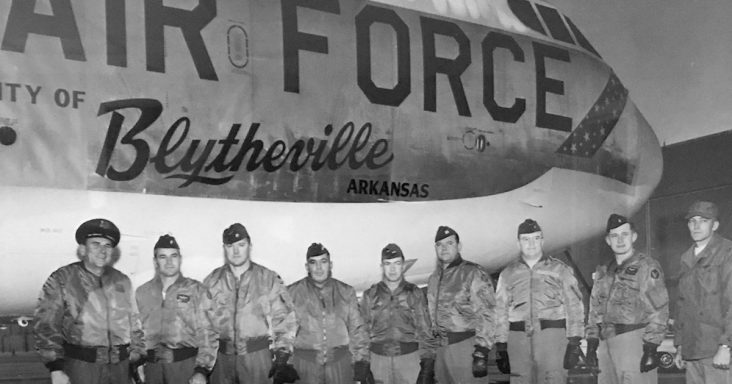Blytheville warming up for Cold War museum at defunct Air Force base
by June 6, 2019 3:21 pm 3,480 views

Tensions between the world’s two great superpowers had reached a boiling point. In early October 1962, the Soviet Union started to build missile installations on the communist-controlled island country of Cuba. The Cuban Missile Crisis reached its zenith on Oct. 22, 1962.
President John F. Kennedy delivered a national address and rebuked the Soviets for their actions. The U.S. military went to DEFCON II and the world poised for war. In Northeast Arkansas, two B-52G bombers loaded with nuclear payloads were placed on airborne alert at Eaker Air Force Base in Blytheville. The bombers’ mission, should war erupt, would be to strike the Soviet Union with nuclear arms.
The crisis lasted several weeks, but ended when the Soviets backed down from placing missiles in Cuba. It was the closest time the Cold War came to igniting World War III, according to historians.
The base made Blytheville one of the most important and strategic cities during the Cold War and a non-profit group hopes the base will lure thousands of tourists to the once bustling city, Blytheville Area Chamber of Commerce Executive Director Liz Smith told Talk Business & Politics.
The chamber and the Blytheville-Gosnell Regional Airport Authority have teamed to form a group that plans to build The National Cold War Museum. The museum will center on the base’s still-intact “alert” compound, a facility that housed U.S. Air Force B-52 crews during wartime efforts of the 1950s through the 1990s. The museum could cost up to $20 million to build, and officials hope it can be open within the next four years, Smith added. R. Byron Carlock Jr., a Blytheville native, is spearheading fund development.
“We are aggressively looking at this project … it will be built in phases,” Smith said. “We’ve been very encouraged so far.”
As a precursor to the museum, the group will open a Blytheville Air Force Base exhibition, which will highlight key points in the history of the Strategic Air Command base that was home to over 300,000 people over the years. Plans call for the exhibition to open during the summer, museum board chair Mary Gay Shipley said.
“The entire base represents a fascinating time in American history,” Shipley said. “Nuclear threat was a reality and the country prepared itself in a variety of ways. One of the most interesting was the idea of keeping crews on alert with the ability to be airborne in minutes. We realize this will be work, but it is absolutely work worth doing given its educational value and the impact it will have in Arkansas.”
In 2018, the air base was placed on the National Register of Historic Places. Since that time, a feasibility study has projected that a full museum would likely draw over 50,000 visitors annually after three years, Shipley said. An additional study evaluated structural design and cost implications.
“And as we bring more people into the process — former Blythevillians, military retirees and area business people — the optimism only builds,” she said.
The Blytheville base opened in 1942 when it was chosen as a flying school site, according to the Encyclopedia of Arkansas. It closed in 1945 as World War II ended, but reopened in 1955 as a Tactical Air Command venue, becoming a Strategic Air Command base two years later. Airmen were housed in a Crew Readiness Center, prepared to launch aircraft and missiles in the event of an attack by the USSR, according to the group.
The base also played a role in the Vietnam War when B-52s were launched and deployed on bombing missions. A BAFB bomber was the first plane down in Operation Linebacker II targeting North Vietnam. A memorial at the Blytheville site commemorates that event and honors the crewmen killed in action. Renamed Eaker Air Force Base in 1988 honoring Gen. Ira Eaker, the entire facility closed in 1992.
During Eaker’s height, Blytheville was roughly the same size as Jonesboro, Smith said. It boasted a vibrant downtown and it had an eclectic population due to the wide variety of people the base brought to the city.
Times changed after the base closed, she said. Blytheville sits in Mississippi County, which has seen a population decline of 11.3% since 2010. Today, there are just over 41,000 residents, according to the U.S. Census Bureau. The median household income of $36,417 is almost $20,000 less than the national average and is also below the state and region averages. Nearly one in four residents in the county live at or below the federal poverty line.
Smith said the city and county need a game changer and this museum might fit the bill. The restored Johnny Cash boyhood home is in the county, and in nearby Marion there’s an effort underway to build a large museum dedicated to the Sultana disaster. The Sultana was a steamer that sank in the Mississippi River April 27, 1865, killing more than 1,200 people. It’s the worst maritime disaster in U.S. history.
The Cold War Museum board hopes to learn lessons from the group in Marion and those in Fort Smith where the Marshall’s Museum is being built. At some point, the group also wants to hire an executive director to spearhead its efforts, she added. Marketing materials are being developed, lists of potential corporate and private donors are being formed, and the group will also look into grant options, Smith said.
Blytheville, and the rest of Mississippi County, have a rich history that is tied to the base and Smith hopes it can be shared with people all over the country and world.
“We get calls all the time about the air force base,” she said. “We have a story to tell.”
